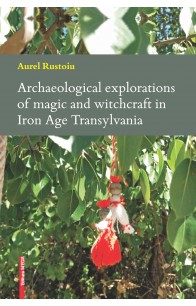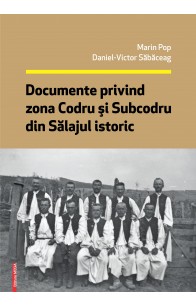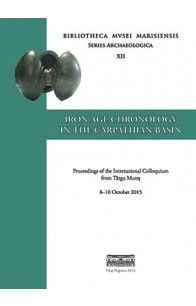Rezultate căutare pentru 'Daniel Victor S��b��ceag'
Link -> http://www.z-studarch.ro/
CONTENTS
Octavian Cristian Rogozea
Discoveries Attributed to the Early Vinča Phase in Tărtăria “Gura Luncii” (Alba County). The 214 Preventive Archaeological Researches Performed on “Site 10B”
Georgeta El Susi
Animal Bones from the Neolithic (Szakalhat) Levels at Uivar (Timiş County)
Victor Sava, Florin Mărginean, Adrian Ursuţiu
The Eneolithic Cemetery in Pecica “Est” (Arad County)
Tünde Horváth
Budakalasz, ein besonderer Bestattungsplatz der Badener Kultur. Kritische Anmerkungen zum Buch: Maria Bondar – Pal Raczky (Red.): The Copper Age cemetery of Budakalasz
Tobias L. Kienlin, Klára P. Fischl, Liviu Marta
Exploring Divergent Trajectories in Bronze Age Landscapes: Tell Settlement in the Hungarian Borsod Plain and the Romanian Ier Valley
Călin Ghemiș
The Late Bronze Age Gold Ring Discovered in Betfia (Bihor County, Romania)
Liliana Daniela Mateescu-Suciu
Glass Recipients from Sarmizegetusa Regia. Unguentaria and Bottles
Horațiu Cociș
The Rural Landscape of the Frontier of Dacia Porolissensis. A Case Study: the Northern Sector –
territorium Arcoba(da)rense – The Valley of River Someșul Mare
Norbert Kapcsos
Sarmatian graves from Pecica Site 18. Remarks upon the phenomenon of „isolated” graves from the Cris-Tisa-Mures region
Ioan Stanciu
On Early Medieval Roasting Trays and their Presence in the Settlements from the North-Western Part of Romania
Călin Cosma, Adrian Bolog, Ovidiu Oargă
Avar Graves Recently Discovered in Gambaș (Alba County) on the Spot Called “Ogoarele de jos”
Dan Băcueț-Crișan, Gruia Fazecaș, Doru Marta
An Early Medieval Feature Discovered in Oradea – Salca “Ghețărie” (Petrom Gas Station)
Daniela Tănase, Gábor Bertók, Anita Kocsis, Balázs Major
The location of Egres Cistercian monastery – Igriş (Timiș County), in the light of recent geophysical research
Florin Mărginean, Zsolt Csók, Keve László, Victor Sava
Unveiling History. Archaeological Excavations in the Fortress of Ineu (Arad County)
Dorel Micle, Bogdan Alin Craiovan, Andrei Stavilă, Octavian-Cristian Rogozea
The Times before Fischer’s Furniture Store. The Preventive Archaeological Researches in Sfântul Gheorghe Square 2–3, Timișoara (Timiş County)
Andrea Demjén, Florin Gogâltan
The Ciuc-Ghimeș Quarantine (18th–19th Centuries). Archaeological Researches of the Former Customs Point “Cetatea Rakoczy”
Abbreviations
Contents
Preface (Vincent MEGAW)
Miloš JEVTIĆ
Basarabi and Ferigile Finds on the Border Between the Carpathian Basin and Central Balkans. Contribution to the Early Iron Age Chronology
Emilian TELEAGA–Dorin SÂRBU
The Chronology of the Late Hallstatt Cemeteries at the Lower Danube: Szentes–Vekerzug and Ferigile
Prisca BARTOLI
Knives with Spoon-Shaped Handle Terminal: a Potential Chronological Indicator?
Tiberius BADER
Ein Vergleich zwischen der Chronologie für Eisenzeit im östlichen Teil des Karpatenbeckens und im südwestdeutschen Raum, bzw. Baden-Württemberg. Ein allgemeiner Überblick
Maciej KARWOWSKI–Jiří MILITKÝ
The Relative and Absolute Chronology of Celtic Oberleiserberg
Mitja GUŠTIN–Boris KAVUR
Early La Tene Warrior Graves from Unterpremstätten-Zettling and Dobl-Zwaring (Styria/Austria)
Marko DIZDAR
Middle La Tene Female Iron Belts in the South-Eastern Part of the Carpathian Basin – is it Something Local and/or Global?
András JÁKY
Periodization of the Settlement of Balatonboglár–Berekre-Dűlő in the Iron Age
Borbála MARÁZ
The Chronology of the Late La Tene Period on the Tribal Territory of Eravisci, on the Basis of Historical Events and Painted Pottery
Attila HORVÁTH M.
Problems about the Change of Periods and Rites in the La Tene Cemetery on Csepel Island (Budapest)
Károly TANKÓ
Chronological Aspects of Ceramic Types from Recently Investigated La Tene Settlements in Hungary
Péter F. KOVÁCS
Chronological and Typological Problems of a La Tene Settlement Section from the Great Hungarian Plain
Katalin ALMÁSSY
Typology and Chronology: the First La Tene Horizon in the Upper Tisza Region
Branislav KOVÁR
The Settlements of the Hron, Ipeľ, Slaná and Rimava River Basins during the La Tene Period
Aurel RUSTOIU
Some Questions Regarding the Chronology of La Tene Cemeteries from Transylvania. Social and Demographic Dynamics in the Rural Communities
Iosif Vasile FERENCZ–Cristian C. ROMAN
One Landscape Two Settlements in the Late Iron Age Site at Tărtăria–Pietroşiţa, Alba County
Andreea DRĂGAN
Chronology of the Eastern Late La Tene Painted Pottery at Divici–Grad in the Iron Gates of the Danube
Emilian TELEAGA
Schwerter aus der Region des Eisernen Tores. Ein chronologischer Beitrag der Mittel- und Spät-La-Tene-Waffengräber
Marija LJUŠTINA–Miloš SPASIĆ
Brothers-In-Shears in the Afterlife: La Tene Warrior Panoply and Chronology at Belgrade–Karaburma
Mariana EGRI
The Beograd 4 Horizon in the Scordiscian Environment. Chronological Delimitation and Interpretation
Dragoș MĂNDESCU
The Chronology of the Rhodian Stamped Amphora Handles in the South-Eastern Proximity of the Carpathian Basin. A Case Study: the Late Iron Age Settlement at Cetățeni
Sebastian MATEI
Elements for a Chronological Framework of the Dacian Fortress from Târcov, Buzău County
Daniel SPÂNU
Iron Age Fibulae from Zimnicea in their Archaeological Contexts
ABBREVIATIONS
„La sfârşitul celui de-al Doilea Război Mondial, ţara noastră avea să intre în sfera de influență a U.R.S.S. Încă din timpul războiului Stalin afirma, şi dădea de înţeles aliaţilor, că acest război va fi altfel şi că imperiul sovietic îşi va impune propriul său sistem, până acolo unde va ajunge armata sa. Cu toate că Iuliu Maniu şi ceilalţi lideri ai partidelor istorice au sperat, până în ultimul moment, în ajutorul S.U.A., Angliei şi Franţei, acest lucru nu s-a întâmplat, Europa fiind împărţită în sfere influenţă. Din păcate, ţara noastră a căzut în sfera de influenţă a imperiului sovietic, condus de către dictatorul Stalin, care a reuşit să-şi impună regimul şi în România, până în anul 1947, cu ajutorul Partidului Comunist din România, un partid minuscul ce nu avea decât aproximativ 1000 de membri la 23 august 1944.” (din „Studiu introductiv”)







